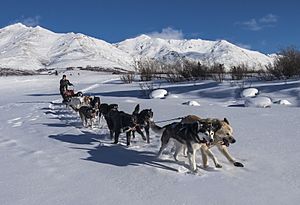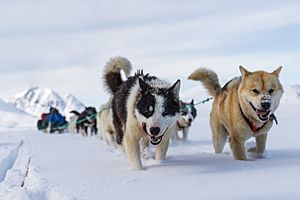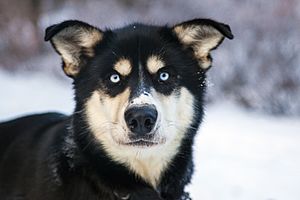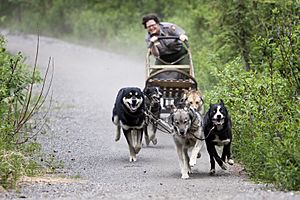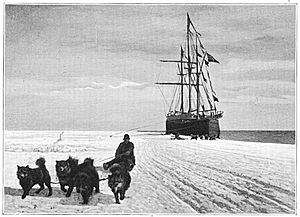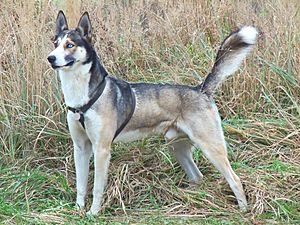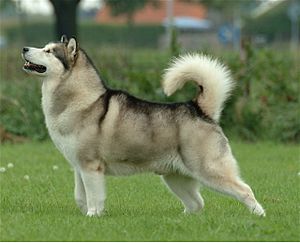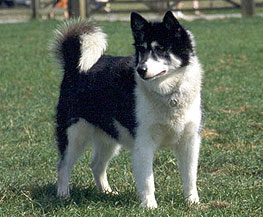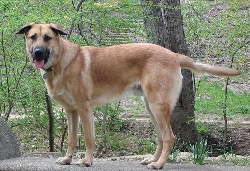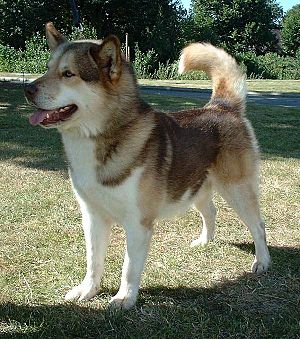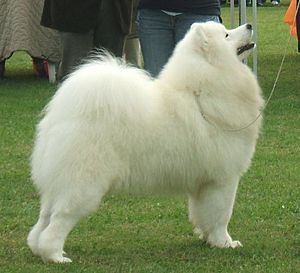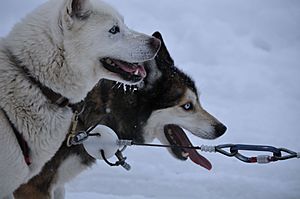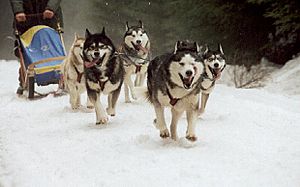Sled dog facts for kids
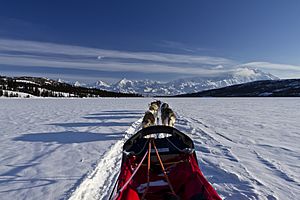
Sled dogs are special dogs used to pull sleds over snow and ice. People in the Arctic have used them for at least 9,000 years. These dogs were very important for travel and moving supplies. They helped people get to places that were hard to reach.
Sled dogs were used in exploring the North and South Poles. They also played a big role during the Alaskan gold rush. Sled dog teams even delivered mail to towns in Alaska and northern Canada. Today, some communities still use sled dogs. They are also popular for fun activities and races, like the famous Iditarod Trail and the Yukon Quest.
Contents
History of Sled Dogs
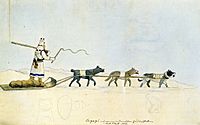
Sled dogs have been used in many cold places around the world. These include Canada, Lapland, Greenland, Siberia, Chukotka, Norway, Sweden, Finland, and Alaska.
Ancient Sled Dogs in Siberia
A study in 2017 found that domestic dogs lived on Zhokhov Island in Arctic Siberia 9,000 years ago. This island was connected to the mainland back then. These ancient dogs were specially bred. Some were used for pulling sleds, and others for hunting.
Sled dogs work best when they weigh about 20–25 kilograms (44–55 pounds). This helps them control their body heat. The ancient sled dogs found were between 16–25 kilograms (35–55 pounds). This is similar to the size of modern Siberian Husky dogs. Some larger dogs, weighing about 30 kilograms (66 pounds), were also found. These might have been mixed with wolves and used for hunting polar bears. When these dogs died, their heads were carefully removed. This suggests it was for special ceremonies.
Sled Dogs in Greenland
The Greenlandic Inuit people have used sled dogs for a very long time. They are still widely used today. In 2010, about 18,000 Greenland dogs lived in western and eastern Greenland. These dogs are very important to their culture. They are the only dogs allowed in these areas to keep the breed pure. About half of them were actively used by hunters and fishers.
However, the number of Greenland dogs has been falling. This is because there is less sea ice, more people use snowmobiles, dog food costs more, and some diseases affect the dogs. By 2016, there were 15,000 Greenland dogs. Projects have started to make sure Greenland's dog sledding culture and knowledge are not lost.
The Sirius Patrol is a special military unit in Denmark. They use dog sleds to patrol the remote northeast of Greenland. This area is mostly empty and is a national park. They travel long distances by dog sled, also recording any wildlife they see. Between 1978 and 1998, their patrols covered about 14,876 kilometers (9,244 miles) each year. By 2011, wolves had moved into eastern Greenland. They followed these dog-sled patrols for distances up to 560 kilometers (350 miles).
Sled Dogs in North America
A 2019 study showed that the first dogs in the North American Arctic came from Siberia. But later, new dogs came with the Inuit people about 2,000 years ago. These Inuit dogs had more varied genes and looked more different than the earlier dogs. Today, Arctic sled dogs are the last dogs in the Americas from this ancient dog family, before Europeans arrived.
Records show that Native American groups used dogs and dog harnesses before Europeans came. Using dogs to pull things was common across North America. There were two main types of sled dogs. One type was kept by people living near the coast. The other type was kept by people living inland, like the Athabascan Indians. These inland dogs became the basis for the Alaskan Husky.
In the mid-1800s, Russian traders traveled inland along the Yukon River. They got sled dogs from villages along the river. These dogs were known to be stronger and better at pulling heavy loads than the Russian sled dogs.
The Alaskan Gold Rush made people interested in sled dogs again. Most gold camps could only be reached by dog sled in winter. Sled dogs moved everything during the cold season: prospectors, trappers, doctors, mail, and supplies. This led to the late 1800s and early 1900s being called the "Era of the Sled Dog."
Sled dogs delivered mail in Alaska from the late 1800s to the early 1900s. Malamutes were a favorite breed. Teams usually had eight to ten dogs. Dogs could deliver mail even when boats, trains, and horses could not move. Each team pulled between 227 and 318 kilograms (500 and 700 pounds) of mail. The mail was kept in waterproof bags. By 1901, dog trails were set up along the entire Yukon River. Mail delivery by dog sled ended in 1963. The last mail carrier to use a dog sled, Chester Noongwook, retired.
Airplanes started delivering mail in Alaska in the 1920s and 1930s. In 1924, Carl Ben Eielson made the first Alaskan airmail delivery. Sled dogs were used to patrol western Alaska during World War II. Highways and trucking in the 1940s and 1950s, and the snowmobile in the 1950s and 1960s, caused fewer working sled dogs to be used.
People started recreational mushing to keep the tradition alive. The goal changed from strong, load-pulling dogs to faster, high-endurance dogs for racing. This made the dogs lighter. Americans began bringing in Siberian Huskies to make their own dogs faster.
Outside of Alaska, dog-drawn carts were used to pull goods for sellers in cities like New York.
Nome, Alaska and the Iditarod Race
In 1925, there was a serious disease outbreak in Nome, Alaska. Not enough medicine was available in Nome. Medicine was in Nenana, but it was about 1,127 kilometers (700 miles) away. The only way to get it was by dog sled. A dog sled relay was organized. Twenty teams worked together to bring the medicine to Nome. The medicine reached Nome in six days.
The Iditarod Trail was created on the path between these two towns. It was called the Iditarod Trail because Iditarod was the largest town on the trail at the time. In the 1940s, the trail was not used much. However, in 1967, Dorothy Page had 14 kilometers (9 miles) of the trail cleared for a dog sled race. In 1972, the US Army surveyed the trail. In 1973, the Iditarod race was officially started by Joe Redington, Sr. Dick Wilmarth won the first race, taking three weeks to finish.
The modern Iditarod is a long sled dog race, about 1,770 kilometers (1,100 miles) long. It usually lasts for ten to eleven days, depending on the weather. It starts in Anchorage, Alaska on the first Saturday in March. Mushers run about 32 kilometers (20 miles) to Eagle River. This lets people watch the dogs and mushers. Then, the teams are driven about 48 kilometers (30 miles) to Wasilla for the official race start. The race ends when the last musher either quits or crosses the finish line in Nome. The winner gets a prize of US$50,000. It is known as the "World Series of mushing events" and "The Last Great Race on Earth."
Sled Dogs in Antarctica
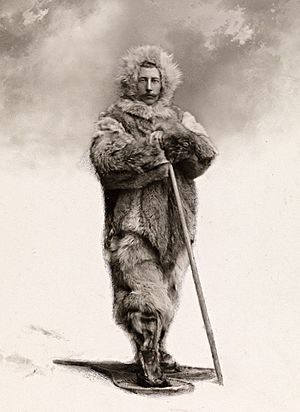
The first explorers in the Arctic used sled dogs. People thought dogs would also be useful in Antarctica. Many explorers tried to use them there. Sled dogs were used until 1992. They were then banned from Antarctica by a treaty. This was because people worried the dogs might spread diseases to seals.
Carsten Borchgrevink used Samoyed sled dogs in Antarctica from 1898–1900. But it was much colder than expected. The dogs were used to snow, not ice, and milder temperatures. They were also not fed enough, and all the dogs died.
Erich von Drygalski used sled dogs in his 1901–1903 trip. He did much better because his dogs were used to the cold. He also hired an experienced dog handler. His dogs were allowed to have puppies. Many had to be shot because there was no room on the ship to take them home. Many others were left behind on the Kerguelen Islands.
Otto Nordenskjold planned to use sled dogs in his 1901–1904 trip. But all but four of his dogs died on the way south. He got more dogs in the Falklands. But these were all killed by Ole Jonassen's huskies when he arrived, as Ole had not tied up his dogs. These huskies later pulled 265 kilograms (584 pounds) over 29 kilometers (18 miles) in three and a half hours.
Robert Falcon Scott brought twenty Samoyeds. The dogs struggled in the conditions Scott put them in. Four dogs pulled heavy sleds through 45 centimeters (18 inches) of deep snow with bleeding feet. Scott blamed their failure on bad dried fish.
Douglas Mawson and Xavier Mertz were part of a three-man sled team. They were exploring King George V Land, Antarctica. On December 14, 1912, one team member fell into a hidden crack in the snow. He was never seen again, along with most of their food. They had to eat their remaining dogs on their 507-kilometer (315-mile) journey back. The dog meat was tough and had no fat. Each dog gave little meat. Most of it was fed to the remaining dogs, who ate the meat, skin, and bones. The men also ate the dogs' brains and livers. Eating too much dog liver can cause a sickness called hypervitaminosis A. Mertz got very sick and died on January 7, 1913. Mawson continued alone and made it back to camp.
Roald Amundsen planned his trip around 97 sled dogs. On his first try, two dogs froze to death in -56 degrees Celsius (-69 degrees Fahrenheit) temperatures. He tried a second time and succeeded. Amundsen traveled about 27 kilometers (17 miles) a day. He stopped every 5 kilometers (3 miles) to build a pile of rocks to mark the trail. He had 55 dogs with him. He kept reducing the number until he had 14 left when he returned from the pole. On the way back, a man skied ahead of the dogs. He hid meat in the rock piles to encourage them to run.
Sled Dog Breeds and Traits
Original sled dogs were chosen for their size, strength, and ability to keep going. But modern dogs are bred for speed and endurance. Most sled dogs weigh about 25 kilograms (55 pounds). Some can be as light as 16 kilograms (35 pounds) or heavier than 32 kilograms (71 pounds).
Sled dogs move very efficiently. Mushers try to have a team where all dogs are similar in size and how they walk or run. This helps the whole team move together, making them more efficient. They can run up to 45 kilometers per hour (28 miles per hour). Sled dogs have tough, webbed feet with toes close together. Their webbed feet act like snowshoes.
A dog's fur depends on its job. Dogs that pull heavy loads need thick, warm coats. Sprint dogs have shorter coats that let heat out. Most sled dogs have a double coat. The outer coat keeps snow away. The waterproof inner coat provides warmth. In warm weather, dogs can get too hot. Their tails protect their nose and feet from freezing when they sleep curled up. They also have special blood vessels in their legs to prevent frostbite.
A good appetite is important for sled dogs. Dogs that are picky off the trail might be even pickier on the trail. They eat diets high in fat. On the trail, they might eat oily salmon or fatty sea mammals. Sled dogs also need to get along well with other dogs.
Popular Sled Dog Breeds
Alaskan Husky
The Alaskan husky is the most common dog in dog sled racing. It is a mixed-breed dog bred especially for its performance as a sled dog.
Dogs first came to the Americas 12,000 years ago. But people and their dogs did not settle in the Arctic until the Paleo-Eskimo people 4,500 years ago. Then came the Thule people 1,000 years ago, both from Siberia. A 2015 study showed that the Alaskan husky, Siberian Husky, and Alaskan Malamute are closely related. They share genes with sled dogs from Siberia. They are different from the two Inuit dogs, the Canadian Eskimo Dog and the Greenland dog. The modern Alaskan Husky has been mixed with other breeds like Pointers, Shepherds, and Salukis for over a century to improve their performance. Sometimes, Alaskan huskies are called Indian Dogs. This is because the best ones supposedly come from Native American villages in Alaska and Canada. They usually weigh between 18 and 34 kilograms (40 and 75 pounds). They can have dense or sleek fur. Alaskan huskies look very different from the typical husky breeds they came from, and from each other.
There are two types of Alaskan huskies based on their genes: a sprinting group and a long-distance group. Alaskan Malamutes and Siberian Huskies contributed most to the long-distance group. English Pointers and Salukis contributed most to the sprinting group. Anatolian Shepherd Dogs added a strong work ethic to both types. Many Alaskan huskies are partly Greyhound, which makes them faster.
Alaskan Malamute
Malamutes are large, strong dogs used for pulling heavy loads. They weigh between 36 and 54 kilograms (80 and 120 pounds). They have round faces with soft features. Malamutes are thought to be one of the first dog breeds to be tamed. They came from the Kotzebue Sound area of Alaska. These dogs are known for their wide chests, thick coats, and tough feet. Speed is not important for these dogs. Instead, their pulling strength is key. They are used for long trips and hauling heavy loads. Malamutes were the preferred dog for hauling and messenger work in World War II.
Canadian Eskimo Dog
Also known as the Exquimaux Husky, Esquimaux Dog, and Qimmiq, the Canadian Eskimo Dog comes from the native sled dogs used by the Thule people of Arctic Canada. This breed was mainly developed by the Canadian government. It can pull between 45 and 80 kilograms (99 and 176 pounds) per dog. They can travel distances between 24 and 113 kilometers (15 and 70 miles). The Canadian Eskimo Dog was also used for hunting. They helped Inuit hunters catch seals, muskoxen, and polar bears.
Chinook
The Chinook is a rare sled dog breed. It was developed in New Hampshire in the early 1900s. It is a mix of Mastiff, Greenland Dog, German Shepherd, and Belgian Shepherd. It is the state dog of New Hampshire. It was recognized by the AKC as a Working breed in 2013. They are described as strong and athletic with a "tireless gait." Their fur color is always a tawny (light brown) shade, from pale honey to reddish-gold.
Greenland Dog
Greenland Dogs are Eskimo dogs from Greenland. They are heavy dogs with great endurance but not much speed. They are often used for dog sled adventures and long trips. In 2016, there were about 15,000 Greenland Dogs in Greenland. However, the number was much higher decades ago. Projects have started to help the breed survive. In many areas north of the Arctic Circle in Greenland, they are the main way to travel in winter. Most hunters in Greenland prefer dog sled teams over snowmobiles because dog sled teams are more dependable.
Samoyed
The Samoyed was developed by the Samoyede people of Siberia. They used them to herd reindeer and hunt, as well as pull sleds. These dogs were so valued that the people depended on them to survive. The dogs were even allowed to sleep in the tents with their owners.
Siberian Husky
The Siberian Husky is smaller than the similar-looking Malamute. It can pull more weight for its size than a Malamute, but not for as long. They weigh between 18 and 27 kilograms (40 and 60 pounds). They have been specially bred for both their looks and their pulling ability.
Other Breeds Used as Sled Dogs
Many other dog breeds have been used as sled dogs. These include Poodles, Irish Setters, German Shorthaired Pointers, Labrador Retrievers, Newfoundlands, Chow Chows, and St. Bernards.
World Championships
The FSS held the first World Championships (WCh) in Saint Moritz, Switzerland, in 1990. It had classes only for Sled Sprint (10-Dog, 8-Dog, and 6-Dog) and Skidog Pulka for men and women. 113 competitors took part. At first, World Championships were held every year. But after the 1995 events, it was decided to hold them every two years. This gave host organizations more time to prepare.
Famous Sled Dogs
Togo
Togo was the lead sled dog for Leonhard Seppala's team. They were part of the 1925 serum run to Nome in Alaska.
Katy Steinmetz wrote in Time Magazine that Balto often gets credit for saving Nome. But Balto only ran the last 89-kilometer (55-mile) part of the race. Togo did most of the work. His journey was 322 kilometers (200 miles) longer. It included a dangerous trip across Norton Sound, where he saved his team and driver.
Balto
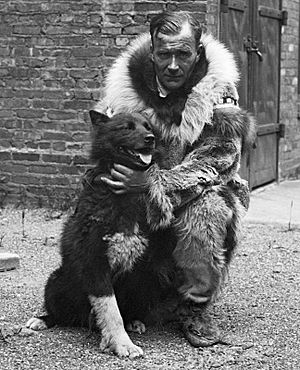
Balto was the lead dog of the sled dog team that carried the medicine for the disease during the last part of the 1925 relay to Nome. His musher was Gunnar Kaasen, who worked for Leonhard Seppala. Seppala had also bred Balto.
In 1925, ten months after Balto's run, a bronze statue was put up in his honor. It is in Central Park near the Tisch Children's Zoo. Children often climb the statue to pretend to ride the dog. The plaque at the base of the statue says "Endurance · Fidelity · Intelligence." Balto's body was preserved after he died in 1933. It is on display at the Cleveland Museum of Natural History.
In 1995, a Universal Pictures movie called Balto was released. It was based on his life.
Other Famous Sled Dogs
Anna was a small sled dog on Pam Flower's team. Pam Flower was the first woman to cross the Arctic alone. Anna was known for being the smallest dog on the team. A picture book was made about her journey.
There are many stories about blind sled dogs who kept running. They either ran on their own or with help from other dogs on their team.
Sled Dogs in Popular Culture
Books About Sled Dogs
Many authors have written about sled dogs.
- My Dogs in the Northland (1902) by Egerton Ryerson Young. This book is about Egerton's adventures with his 12 sled dogs.
- The Call of the Wild (1903) by Jack London. This famous story is about sled dogs and their lives during the Gold Rush. Jack London used Young's book as a source.
Movies About Sled Dogs
- Call of the Wild (1935)
- Balto (1995)
- Snow Dogs (2002)
- Eight Below (2006)
- Sun Dogs (2006)
- Snow Buddies (2008)
- Togo (2019)
Images for kids
-
Carrying the mail and the weekly Klondike Nugget, this service covered all the creeks adjacent to Dawson City. The service was established by Jean (or Gene) Allen in 1898
-
Huskies ready to ride at the husky farm in Kuusamo, Finland
-
Labrador huskies being fed by Inuit
See also
 In Spanish: Perro de trineo para niños
In Spanish: Perro de trineo para niños


